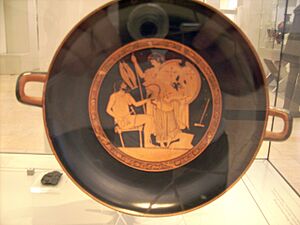Berlin Foundry Cup facts for kids
The Berlin Foundry Cup is a very old drinking cup from ancient Greece, made around 500 BC. It's a type of cup called a kylix, and it's famous for its amazing red-figure paintings. These paintings show how people in Athens (a big city in ancient Greece) made bronze statues. The cup is named after the artist who painted it, who we call the Foundry Painter. It's a really important object because it teaches us a lot about how ancient Greeks worked with metal.
Contents
The Amazing Cup
The inside of the cup has a picture that connects directly to metalwork. It shows Hephaistos, who was the Greek god of crafts and metalworking. He is giving special armor and weapons to the goddess Thetis. This armor was for her son, Achilles, a famous hero who was fighting in the Trojan War. Achilles needed the armor to get revenge for his friend Patroclus, who had been killed. This scene is from a famous ancient Greek story called the Iliad by Homer. Stories about the Trojan War were very popular on Greek vases.
What's on the Outside?
The pictures on the outside of the cup are very special because they show a real-life bronze workshop. You can see different steps of making bronze statues.
On one side (called side A), there's a huge statue of a warrior, even bigger than a real person. It stands inside a wooden frame, like scaffolding. The warrior statue has a round shield in its left hand and is ready to throw a spear with its right. The helmet on the statue has its cheek-guards lifted up. The painter probably did this so you could see the statue's face better. It looks like this statue is almost finished. Two workers are smoothing or polishing its surface. One of them wears a special leather cap, which shows he's a smith (a metalworker). Two other men are watching them, leaning on sticks. They don't seem to be workers or the workshop owners. They might just be people passing by, maybe on their way to or from the palaestra, which was a place for sports. You can see sports gear, like an oil flask and a strigil (a tool for scraping sweat and oil off the body), hanging behind them. This suggests they were involved in athletic activities.
On the other side (called side B), another statue is being made. This one looks like an athlete. The statue doesn't have a head yet and is lying on a bed of sand or clay. A worker is holding one of its arms, carefully tapping it with a hammer. The statue's head is lying on the ground near his feet. There's a line between the statue's arm and hand, showing they aren't fully joined yet. The workers would have used a special metal mix (like lead, antimony, and tin) to join them. This mix melts easily. A furnace (a very hot oven) is nearby, probably getting ready to heat the metal for joining. Behind the furnace, a young person is using a bellows to make the fire hotter. In front of the furnace, another worker is sitting and heating a metal rod.
Where Were These Workshops?
Metal workshops like the one shown on the cup were found in the potters' area of Athens, called the Kerameikos. So, it's very likely that the Foundry Painter saw these workshops in real life and painted what he observed. However, some small details, like the furnace, are shown a bit differently from what archaeologists have found. This might be because the artist changed things slightly to make the painting look better. Some of the workers shown in the painting were not free and worked for others.
Special Messages and History
The cup has three special messages called kalos inscriptions. Kalos means "beautiful" in ancient Greek.
- On the inside, it says "O PAIS KALOS" (the boy is beautiful).
- On the outside, side A, it says "DIOGENES KALOS NAICHI" (Diogenes is beautiful, too).
- On the outside, side B, it says "O PAIS KALOS NAICHI" (this boy is beautiful, too).
The cup is in great condition, even though it's so old, except for a few small damaged spots on the figure of Thetis inside. It was made around 490 or 480 BC. The cup is about 30.5 centimeters (12 inches) wide.
In ancient Greece, cups like this were used at parties called symposiums, where men would gather to drink, talk, and enjoy themselves. This particular Foundry Cup was sent to a place called Etruria (which is now part of Italy). It was found in a town called Vulci, probably in a grave. In 1837, the Antikensammlung (a museum in Berlin, Germany) bought the cup. Today, you can see it on display in section 15 of the Altes Museum in Berlin, which is called "The Gods of Greece."
See also
- Bronze sculpture
- Lost-wax casting



